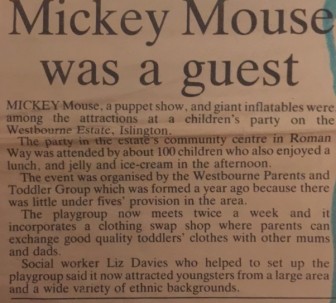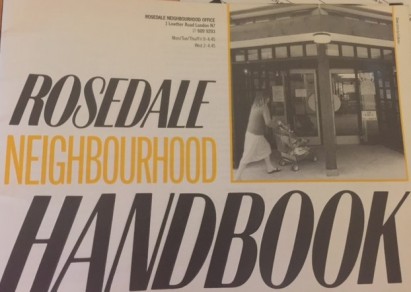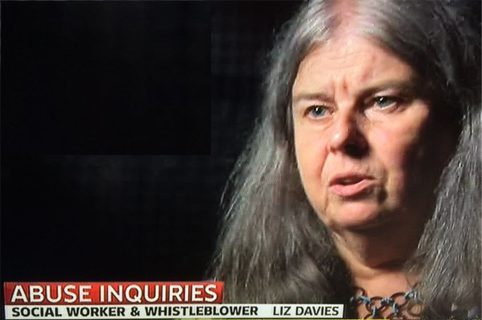Some more recently qualified social workers are gaining a strong voice on social media and even in the mainstream press with all kinds of comment about the professional role of social work. In this context, I thought it would be useful to put across to those hungry for knowledge, a model of social work practice which has been around in the past and worked well.
Protecting children from sexual exploitation and abuse cannot be considered in isolation, but is one key element in an integrated approach to supporting children and families within their communities. … Local people show immense commitment to their children, young people and neighbourhoods. They can provide the resources of time, knowledge, imagination and skills to reduce risks of harm and support environments where children flourish.
(Nelson and Baldwin, 2016)
It was the late 80s and I had a plan – A Children’s Clothing Exchange – a swap shop for children’s clothes as a basis for developing a community network on an inner London council estate. My social work colleagues were severely critical. They said this initiative was definitely not Politically Correct. They said what I was doing was degrading for families who were deserving of new clothes and would be ashamed to have their children seen in hand-me-downs. They said I had not appreciated a local working class culture of being proud and that families would not dress themselves or their children in second hand clothes.
This didn’t make sense to me as I had come from a family where most of my clothes came from jumble sales, relatives and friends. Our next door neighbour gave my mother off-cuts from the clothing trade and as I grew out of knitted cardigans they would be unravelled and re-knitted into a bigger size. Jumble sales provided a good source of wool and fabric that could be re-invented. It was a post-war ‘make do and mend’ approach. Nowadays it’s called recycling.
In 1987, in the patch based office in Islington where I worked, there would be a constant queue of families asking for money towards clothes for their children. Requests always escalated just before the start of the school term. I could give out Section 1 money (Child Care Act 1980 – money to support families and prevent reception into care) up to a sum of £500.00 in one year per family. An amount more than that required the permission of a manager. It was difficult between team members on duty to distribute limited resources fairly to everyone and social work responses were variable. The form we had to complete looks ridiculously simple compared with current IT systems but it did the job and took little time.

I had young children myself and reflected that middle class families passed on good quality children’s clothes which were merely outgrown as well as toys, push chairs, cots and baby baths. There was an endless resource in my home neighbourhood which was not available just a short distance away on the council estate where I worked. This was because there were many isolated parents, a transient population living in temporary housing and families struggled to survive among strangers. However, all families have some items of children’s clothing which have not become worn out, because children grow out of them so fast, and these could be exchanged. The concept of exchange was not demeaning because the power relationship between residents and parents was equal. On the contrary, queuing up to beg social workers for money was demeaning and humiliating. It brought them often unnecessarily to the attention of social services and was a constant reminder that they were being defined as ‘not coping’. Of course they feared their children being removed from their care.
In a local community centre, I set up a swap shop for children’s clothing and other items. Any resident could come and take anything for nothing. They could also donate items their children had grown out of but this was not a requirement.

The parents quickly took on the project themselves and the idea was also taken up by social workers in neighbouring Camden.

They began to provide tea, coffee and a playspace for the children whilst the parents identified the clothing their children needed. Even maternity clothes became included. Clothes were well sorted into age groups and types and some were washed and mended. The parents kept a sharp eye out for dealers who would try and come to bag up clothes to sell on the market. The Clothing Exchange broke down barriers between families who had a common need. They found it empowering because they organised it themselves and no longer had to be anxious week on week about this aspect of child care. It gave them time for other activities. Poverty is after all an exhausting and full time struggle for survival. My mother told me of her childhood in the north where she and her brothers spent hours collecting scraps of coal from the slag heaps (known locally as the ‘mucky mountains’) and trapping sparrows for ‘sparrow pie’.
As the project developed, neighbourhood parties were held and the local press reported on a ‘party attended by over 100 children who ate jelly and ice cream’ and were entertained by puppet shows. The news reporter explained that the playgroup incorporated a clothing swop shop where parents could exchange good quality toddler clothes with other mums and dads from many ethnic backgrounds’. Some of the critical team social workers were upset about Mickey Mouse being mentioned saying he was a symbol of white imperialism – but the parents knew someone with a Mickey Mouse outfit and had made their choice.

It was a simple idea in response to the visible need of families in poverty. The local community got to know us better as local social workers and began to alert us when they were worried about children being abused. They had their own understanding of what was and was not acceptable and appreciated a relationship where they could check out with us whether or not we thought a child was at risk and there needed to be an investigation. Because social workers were supporting the clothing project, the families were more willing to open up to us with concerns and this enabled some issues to be responded to effectively with the help of community networks.
Situations could be monitored over time better assisting decisions about when and if it was necessary to intervene. I remember a 4 year old child who it was said the mother neglected though the evidence was unclear. The local community would see the child, take her in, feed her and help care for her. They came to the Clothing Exchange to tell us that the situation couldn’t go on, the child had been found asleep on the pavement on a cold night. They demanded we act as they had reached their limits of community support.
In another situation local women reported a man on the estate who took in young boys and let them sleep on his floor. They were concerned that he might be abusing them. Police set up an observation and also discovered that the adult had a long criminal history of procuring boys for child sexual exploitation. A number of boys gained protection.
As community social workers we were not defined negatively and when the Islington child abuse scandal was becoming exposed some of the local families in a different neighbourhood assisted the investigations. One parent was a postman. He gathered information when he came back from work at 4 am about men in vans who he saw picking up numbers of children from one of the flats. I remember him telling me, ‘Liz you have no idea what goes on here at night’. We had our suspicions and had requested a youth worker be allocated to the neighbourhood to cover the evenings and weekends but this had been refused. This community, once enabled, was protective, worked with us very closely and were supportive of their children coming forward to us with evidence of the abuse.

Community work is not taught on social work courses now (I was fortunate to be taught on the last course at the London School of Economics in 1972) and authorities are not as flexible as Islington and Camden were at that time in encouraging initiatives. Patch social work enabled a real understanding of local community. Neighbourhood Offices were accessible and there were 24 in Islington. I worked in 4 of them, Beaumont Rise, Rosedale, Clocktower and Irene Watson. The last one where I worked was a shop front named after a local councillor. We took a lot of calls from people asking to speak to Irene! Another neighbourhood was called Julie Curtin and the same happened there. Social work specialists from Black and Minority Ethnic groups were based in different offices and were accessible for cultural advice and services. There was a very active Black Workers Group and staff took time out of the working day to attend the meetings which were prioritised by the authority. This supported a philosophy that the social work teams should be culturally representative of the communities they served. The offices provided housing, environmental health and generic social services and residents went there to pay their rent. Each neighbourhood had a small budget to spend on identified local need and a local forum of residents, councillors and staff met once a month to discuss neighbourhood issues. Social workers had to present a report to the forum and I did this in 1990 to Irene Watson Neighbourhood Forum raising my concern about sexual exploitation in the area. As my archive of Islington papers was mislaid by my lawyer I only have the following poor quality copies;


Islington’s multi agency investigations: Families and the local community were actively encouraged and trained to form a network of protective adults. They were the ‘eyes and ears’ when professionals were not around.. Imagine for a moment how effectively the coordination and awareness below would have identified CSE in the English towns and cities where there have been scandals of official inaction (Nelson, 2016 p201).
Nowadays such methods of community work would be said to be a form of state surveillance and might well be used to push the Protect agenda or to be punitive towards parents choosing to home educate their children. Of course, this form of community work can be used for oppressive or liberating ends. This is true of all forms of social work as we are situated at the interface of the state and the citizen and we try and negotiate the boundaries as best we can in favour of the citizen. Current practice is mainly focussed on changing families to fit an unjust, inequitable system rather than struggling with them to promote their rights and to assist campaigning and action towards changing the systems that oppress them.
The community are the eyes and ears for the vulnerable. Without developing some level of trust we risk getting it all wrong. Every community has its network of protective adults who can be supported in identifying and reporting child abuse. There are always abusers, and those who exploit children for financial gain, but there are always protectors as well. If we do not identify the protectors we will not know how to respond to community alerts about abuse as we will find it difficult to evaluate the level of concern. We will under-intervene and over-intervene.
A Clothing Exchange was just one idea – but for a year or so it worked. I later developed this plan into a Local Safeguarding Children Board strategy (Davies, 2004). This was much based on the work of Dr Sarah Nelson of Edinburgh University.
References
Davies, L (2004) The difference between child abuse and child protection could be you. Creating a community network of protective adults. Child Abuse Review, 13:426-432
Davies, L (2014) Working positively with the media to protect children. Journal of Social Welfare and Family Law, 36 (1):47-58
Nelson , S and Baldwin, N (2004) The Craigmillar project: neighbourhood mapping to improve childrens’ safety from sexual crime. Child Abuse Review, 13(6) 415-425
Nelson, S and Baldwin, N (2016) Community prevention of CSA: a model for practice in Nelson, S, Tackling child sexual abuse. Radical approaches to prevention, protection and support. Bristol: Policy Press. Chapter 6.
Nelson, S and Davies, L (2016) ‘Models for ethical, effective child protection’ in Nelson, S, Tackling child sexual abuse. Radical approaches to prevention, protection and support. Bristol: Policy Press. Chapter 5.

You must be logged in to post a comment.